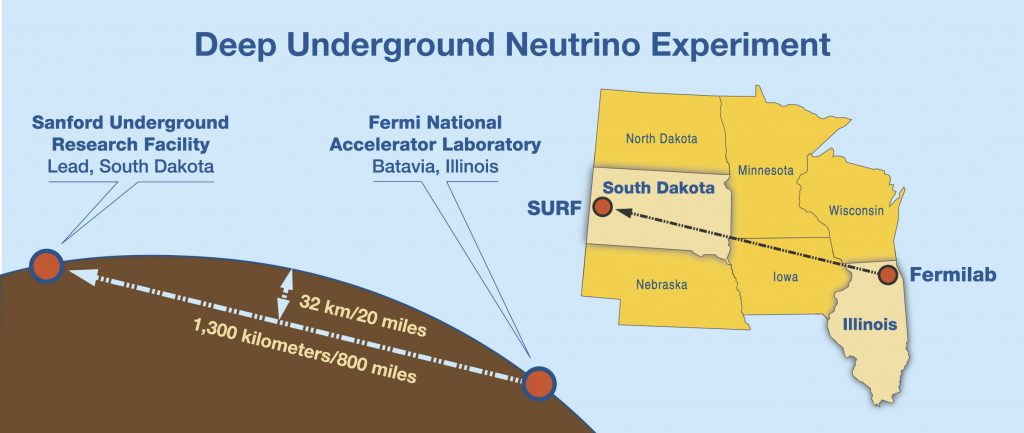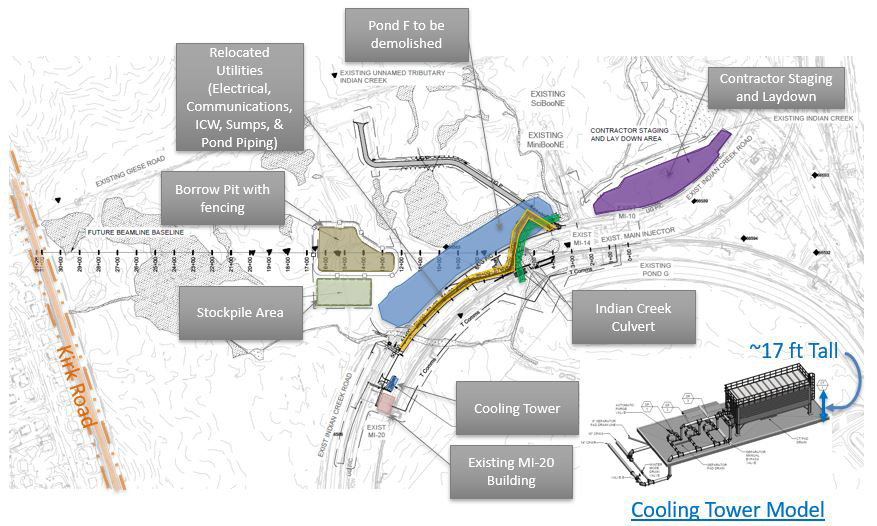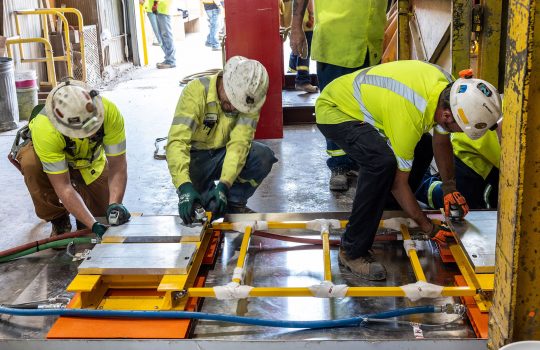Site preparation work starts at Fermilab this fall for the international Deep Underground Neutrino Experiment. Contractors will soon begin site prep where the powerful particle beam will be extracted and sent toward its final destination — gigantic particle detectors in South Dakota.
Building the biggest physics experiment on U.S. soil – and one attempting to answer some of the biggest questions in physics – is no easy feat. More than 1,000 collaborators from over 30 countries are working together on the international Deep Underground Neutrino Experiment, which is hosted by Fermilab and uses facilities in both Illinois and South Dakota. And while work at the far site has been under way for more than a year, this November will see the premiere of site prep activities at Fermilab.
DUNE will investigate mysterious particles called neutrinos and the role they had in the evolution of our universe. To study them, the world’s most powerful beam of high-energy neutrinos will be created at Fermilab and sent through the earth, no tunnel required, to enormous detectors one mile underground at the Sanford Underground Research Facility.

DUNE will study neutrinos by sending the world’s most powerful beam of high-energy neutrinos from Fermilab through the earth to enormous detectors one mile underground at the Sanford Underground Research Facility in South Dakota. Image: Fermilab
Work at Sanford Lab began with an underground groundbreaking in 2017, and teams have been refurbishing the systems that will eventually transport excavated rock a mile to the surface, then almost another mile to where it will be deposited. To make the new caverns that will hold the neutrino detectors, almost 800,000 tons of rock will have to be removed. Individual detector pieces will then be ferried underground and assembled like a ship in a bottle.
With crews hard at work on the receiving end of the experiment in South Dakota, it’s now time to start preparations for work at the starting point: Fermilab’s accelerator complex in Batavia, Illinois. Crews will need to build a new beamline that extracts particles from Fermilab’s largest particle accelerator, the Main Injector, and sends them toward the South Dakota detectors. The infrastructure at the start and end of this 800-mile neutrino journey is known as the Long-Baseline Neutrino Facility – and the LBNF beamline at Fermilab will perhaps be its most sophisticated piece of engineering. But before those new enclosures and magnets and vacuum tubes can be installed, teams will need to create a clean slate for the upcoming construction on the Fermilab site.
“The project site is currently highly congested,” said Kate Sienkiewicz, LBNF conventional facilities deputy project manager at Fermilab. “There’re a ton of utilities – electrical, communication, water – all running through the area. The goal is to clear the conflicting utilities and prepare it so that when facility construction is approved to start, work crews will be able to go straight to work.”

Crews will have plenty of work to coordinate in preparing the Fermilab site for the construction of the Long-Baseline Neutrino Facility. Image: Fermilab
During the fall, the construction contractor for the prep work, Kenny Construction, will prepare their staging area for equipment and set up their offices. During the winter, teams will remove trees from about one acre of the site. And once the ground thaws in the spring, crews will begin moving utilities, running new connections that can be switched over once the annual summer maintenance of the accelerator complex begins. That’s also when a short stretch of Indian Creek will be rerouted and a cooling pond will be drained and filled in, and in anticipation, Fermilab relocated approximately 600 fish (including largemouth bass, bluegill and bluntnose minnow) to other ponds on site in September. Eventually, the road around the Main Injector will also take a detour to accommodate the new layout for the beamline.
“It is exciting to be working with Fermilab on the front line of science innovation,” said Michael Zika, project manager at Kenny Construction. “We look forward to working toward completing this project safely and on schedule to allow this groundbreaking experiment to push forward.”
The impact of the science will be big, but the impact of construction should be small. Trucks and equipment will enter the site from the south on Kautz Road. Tree clearing will happen during the winter to minimize the effect on bats and nesting birds. Crews also intend to work typical work hours during the day, so there should not be excess noise or light for Fermilab’s neighbors. The construction management team will take baselines of light and noise and monitor levels throughout the project.
In the meantime, there’s plenty of other work afoot. Researchers have been developing an accelerator upgrade for Fermilab’s complex called PIP-II. This is the first accelerator project in the United States with major international contributions, and the new linear accelerator will power the chain of accelerators with record intensity. DUNE scientists and engineers have built large prototypes at CERN to test the technology for the gigantic particle detectors in South Dakota, which combined will hold approximately 70,000 tons of liquid argon. Scientists and engineers are finalizing the technical design report that serves as a blueprint, and students are testing equipment, writing software, and running simulations. It’s a busy time to be a part of DUNE and LBNF.
“LBNF is a complex project with thousands of moving pieces. It’s been gratifying to watch the major construction progress at Sanford Lab, and with site prep starting at Fermilab, we know we’re advancing to the next phase of the project,” said Chris Mossey, the Fermilab deputy director for LBNF. “The exciting science this will all support becomes much more tangible when we can see work happening in our own backyard.”
This work is supported by the U.S. Department of Energy Office of Science.



